| Genealogy Grueninger Family |
|
Coat of Arms and own-brands of the Grueninger Family
|
|
|
|
|
|
|
| Genealogy Grueninger Family |
|
Coat of Arms and own-brands of the Grueninger Family
|
|
|
|
|
|
|
|
Authorised carriers of an existing coat of arms are only the direct male descendants of the ancestor who registered it. Historically, the family crest was directly linked to the surname. As such, the right to a name applies also to the family crest. For proof of entitlement to carry a family crest, it should be registered in a role of arms. However, there are many of these. An unauthorised continuation of carrying a family crest can be forbidden by a person which is authorised to carry the subject family crest. In order to demonstrate authorisation, one has to proof his lineage. |
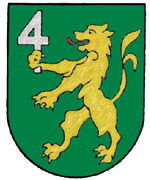
|
Source: Public Record Office of the Canton Schwyz in Switzerland
This gender occurs from the 16th century onwards also in the "March" (area). Konrad Grueniger from Steinen fell in 1386 at Sempach. The Grueninger Family from Steinen had as coat of arms a golden lion in a green shield round in base with a own-brand in his paw. |
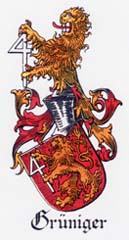
|
Source: Armorial of Uri
Public Record Office of the Canton Uri in Switzerland Jakob Grueniger (Grieniger) may be the progenitor of the Grueninger family in Altdorf (canton Uri). This gender is mentioned the first time in 1487. Jakob brought presumably this gender from Germany to Altdorf. He received in 1524 land-legislation. Furthermore, an Eucharius Grueninger is mentioned before 1518 in a Yahrzeit book of Schattdorf. The coat of arms of the Grueninger family in Altdorf (canton Uri) shows a golden, erected lion in a red shield round in base with a silver own-brand in his paw (a "4" with an extended leg). Jakob Grueninger was married to Anna Scheitler and had two sons, Mathias and Baschi. Mathias Grueninger was married to Margrith Scherer. Their son Johannes Grueninger was notary and captain. He died in 1562 in the Battle of Blainville in France. His corpse was never found. The other captains were buried in the cathedral in Dreux (France). Son of Johannes Grueninger (†1562) and Katharina of Roll was Mathias Grueninger (†1621). He was also captain in France, reeve in Altdorf, and reeve in Baden from 1605 till 1607. In 1607 he was ennobled and granted arms by emperor Rudolf II. Before this granting of arms, the coat of arms of Grueninger family in Altdorf did not feature the silver own-brand (a "4" with an extended leg). |
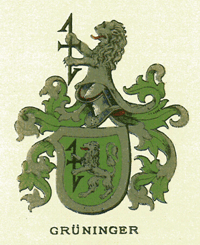
|
Source: The Armorial of the City of Basel
National Library Berlin, Prussian Cultural Heritage The family crest can be traced back to the cooper Christian Grueninger (†1612), who became in 1573 citizen of Basel, his son Mathias Grueninger (*1597), his grandson Mathias (*1645, †1694), and his great-grandson Martin Grueninger (*1678, †1736) which were all coopers. The line of descendants continues with the cooper Johann Jakob Grueninger (*1713, †1775) and Rudolf Grüninger (*1744, †1798) with his two sons Rudolf (*1776, †1823) and Johann Jakob (*1779, †1839). The own-brand in the family crest of the Grueninger family from Basel depicts a "Wolfsangel" (wolf's hook). The "Wolfsangel" is a rune symbol (an old symbol of mysticism), which can be traced back to the early Germanic times. Its shape is based upon a tool, which was supposed to be used for trapping wolves. The upper prong was driven in a tree, and the lower prong served with a bait applied as a "fishhook" for the wolves. However, it is doubted whether such a tool ever was used. At least from the 14th century onwards, the "Wolfsangel" was used as a sign to mark property lines. Further, the symbol is also known as "rune of death" and stands for liberty and freedom. The "Wolfsangel" is also said to feature harm protective energy. |
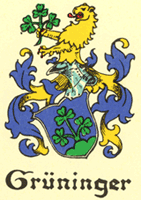
|
Source: Armorial of Glarus
The Grueninger Family of Naefels is an ancestral and catholic gender in the cantony of Glarus. The coat of arms of the Grueninger in Naefels shows three green clover leaves on a green three mole-hill in a blue shield. The helm shows a golden, erected lion with three green clover leaves in his paw. |
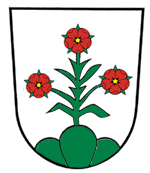
|
Source: Public Record Office of the Canton Schwyz and Canton Uri in Switzerland
The Grueninger family of Altendorf in the region March (canton Schwyz) is not related to the Grueninger gender of the same name in Steinen. The coat of arms of the Grueninger family in Altendorf shows three stylised roses on a green three mole-hill in a white shield. This crest stems from a tomb of Pius Grueninger in Lachen, who was a member of the canton council. Another variant of this crest can be seen on a tombstone in Wangen. It shows an erected branch with seven green leaves on a green three mole-hill in a white shield. Adelheid Grueniger officiated from 1413 till 1439 the master of the cloister Fahr. In 1541, Fridli Grueniger acquired the land-legislation of the March for 20 pounds. Eleven descendants of this gender still lived in 1970 the region March (9 in Altendorf and 2 in Lachen). |
|
Family Crest of the Grueninger Family from Basel-Zurich |
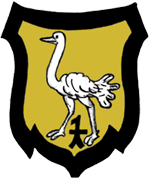
|
Source: Armorial Générale, Rietstap I, page 841
State Archive Baden-Wuerttemberg, Central State Archive Stuttgart |
|
Coat of arms of the municipality Grueningen and, |
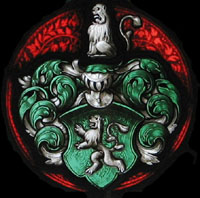
|
Internet Source: Homepage from Hans und Maria Rüegg
Coat of arms disc of the governance Grueningen from the castle Grueningen from 1587 (Victoria and Albert museum in London). The coat of arms disc of the governance Grueningen supposedly took the official coat of arms disc from Zurich as an example. In the middle, it shows the city arms of Zurich, and around the city arms of the different districts of the town and republic Zurich in 1576. In the middle of the coat of arms disc of the governance Grueningen there is the coat of arms of the municipality Grueningen, which is shown here as an extract. It stems presumably from a gender Grueninger which lived in the castle in Grueningen and it was adopted as the city arms of Grueningen. |
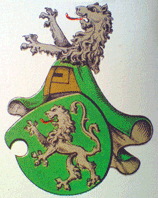
|
Quelle: Der ausgestorbene Adel von Stadt und Landschaft Zürich
Staatsbibliothek zu Berlin, Preussischer Kulturbesitz Not translated yet... |
|
Coat of arms of the Grueninger Family from Diessenhofen |
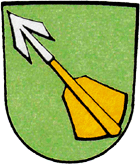
|
Quelle: Thurgauer Wappenbuch
Staatsbibliothek zu Berlin, Preussischer Kulturbesitz |
|
FCoat of arms of the Grueninger Family from Triboltingen |
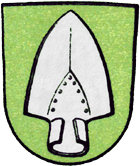
|
Quelle: Thurgauer Wappenbuch
Staatsbibliothek zu Berlin, Preussischer Kulturbesitz |
|
Family Crest of the noble gender of Grüningen (d'Éverdes) |
|
Not translated yet... |
|
Family Crest of the Groeninger Family from Jerwen |
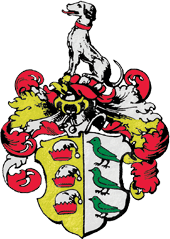
|
Source: Contribution to the Baltic Heraldry
National Library Berlin, Prussian Cultural Heritage |
|
The own-brand of Johann Grueninger |
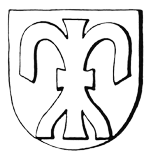
|
Source: Own-brands and Family Crests from Butzbach
in German Genders (Volume 84, Page 586), State Archive Baden-Wuerttemberg, Central State Archive Stuttgart |
|
Family Crest of Joachim Grueninger from Augsburg |
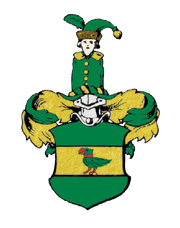
Source: The New "Siebmacher", Volume 5, Section 6, Page 71, Table 73 |
|
Family Crest of Michael Grueninger from Augsburg |
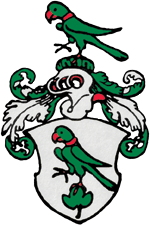
|
On the 24th of November in 1545, a marriage between Michael Grueninger and Veronica Honold in Augsburg is mentioned. As a coat of arms, a parakeet with a red torc and armature is mentioned. Source: Quaterly annual script of Heraldry, Sigillography, and Genealogy
|
|
Family Crest of Lorenz Grieninger from Augsburg |
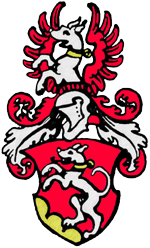
|
Not translated yet... |
|
Family Crest of Johann Christoph Grueninger from Tuebingen |
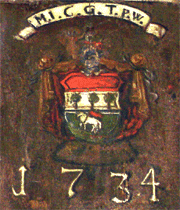 |
|
Magister Johann Christoph Grüninger Tubingensis Pastor Weilheim
|
|
Source: Nikomedes-Church in Weilheim a.N.
(district of Tuebingen) On a plate in the protestant church in Weilheim a.N., there is the coat of arms of the clergyman Johann Christoph Grueninger (*1679, †1743) shown. In the church two paintings can be seen which were donated by him and his 2nd wife. The first painting shows Archangel Gabriel with a lily, the second painting shows Maria, holding in her Hand a book with the magnificat. The gravestone of his second wife Sophie Charlotte, a big flagstone, can also be seen as well as an in latin lettered brazen epitaph, which reminds of clergyman Johann Christoph Grüninger and his two wives. Johann Christoph Grueninger was the son of Johann Wendel Grueninger (*1638, †1703), who was mayor in Tuebingen. In 1724, Johann Christoph issued for his son an application for a scholarship of the Grueninger foundation in Winnenden. However, it was rejected as the lineage to the siblings of the provost Erasmus Grueninger from Winnenden couldn't be proven. The genealogical schemata was not contained, but a later parallel case issued by the descendants of Johann Christoph's sister shows the bogus derivation. The town Weilheim is for sure much older than 900 years. The name indicates an origin in the 7th century. The first records as "Wilon" in 1090 appear in cunjunction with the cloister Zwiefalten, where the church, and thus the town, were first mentioned. |
|
Family Crest of the Grueninger Family from Nagold
Ludwig Grueninger, born September 17th 1876, saddler and paperhanger in Nagold, adopted for his clan the following coat of arms: |
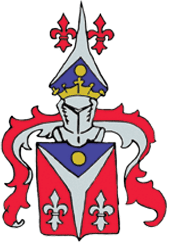
Source: Dochtermann's archive of coats of arms, 548/41 |
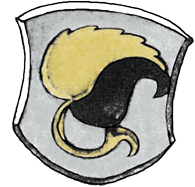
|
Source: The Armorial of Rottenburg, 1602
Archive of the town Rottenburg The Armorial of Rottenburg from 1602 contains the coat of arms of the leading families and genders in the shire of Hohenberg, i.e. the region around the administration center Rottenburg. The coat of arms of Marten Groeninger, mayor, shows a golden artefact in a silver shield. It could be, that subject person was Martin Grueninger (* around 1485, † before 1555), son of Johann (Hans) Grueninger of Entringen (Herrenberg). Martin Grueninger (magistrate) was matriculated in Tuebingen in 1501, was 1509/14 in Rottenburg, and represented Rottenburg in 1527 on the parliament of Innsbruck in Austria. He was in 1530 mayor of Rottenburg, and was married to Margarete, who sold as a widow in 1555 their house close to the market in Rottenburg to Heinrich Kaiss in Tuebingen for 440 fl. The artefact in the coat of arms should represent al "leaf". Interestingly enough, "leaves" also appear in the family crest of the Grueninger family from Winnenden. This suggests a connection between the Grueninger family from Herrenberg and the Grueninger family from Winnenden, Further, also the city arms of Steinen in Switzerland shows six leaves. |
|
Family Crest of the Grueninger Family from Winnenden |
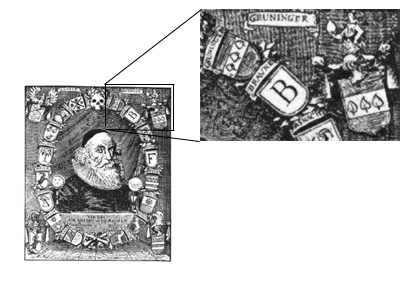
|
Internet Source: Homepage of Dr Edward H. Thompson,
Department of Economic Studies, Dundee University, Scotland. The portrait shows Johann Valentin Andreae. On the left side, the coat of arms from his ancestors are shown. On the right side, the coat of arms from his wife's ancestors are shown. Johann Valentin Andreae (* 17.08.1586 in Herrenberg), theologian and poet, married Agnes Elisabeth Grueninger (* 19.03.1591/92 in Schuetzingen) in Poppenweiler. Her father was Josua Grueninger, born 12.08.1554 in Winnenden. The shown family crest of the Grueninger family stems from her great-grandfather Martin Grueninger (* around 1495 in Winnenden), who was married to Elisabeth Braun. The "B" in the coat of arms stands for the Braun family, which presumably didn't carry a family crest. The shield contains three leaves, presumably in green. Again, as already suggested by the coat of arms of Marten Groeninger from Rottenburg, one could assume that a connection exists between the Grueninger family from Winnenden and the Grueninger from Herrenberg. The city arms of Steinen in Switzerland contains two times three green leaves. |
|
Family Crest of Anna Grueninger |
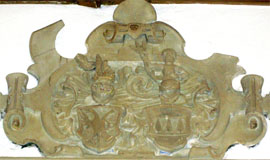
|
Source: Mauritius-church in Schwaikheim
(close to Winnenden) The epitaph for Georg Koelz (†1607) shows the coat of arms of the Koelz family and the coat of arms of his 2nd wife Anna Grüninger (*1556). Anna was a daughter of the mayor Erasmus Grueninger (*1523, †1613) in Winnenden and a sister of the famous provost Erasmus Grueninger (*1566, †1632) in Stuttgart respectively. |
|
Internet Source: Schrag's Roll of Arms (Roll of Arms of Franconia)
(Family Armorial Schrag) Source: The New "Siebmacher", Volume 5, Section 6, Table 72 Source: The german Herold, Magazine for coat of arms, seals and genealogy 1885 The coat of arms of the Grieninger family from Pforzheim shows a black dressed man in a silver targe with a golden belt, golden supplements on his collars and sleeves, with a rose wreath on his head, and with a green bough in his right hand. The treasure shows the same figure and the mantling is black-sliver. The progenitor of the respectable alderman and pharmacist family Grieninger from Pforzheim is Johann Grieninger, who was mayor in Pforzheim. His son Michael Joachim Grieninger (*1538, †1606) was pharmacist and alderman in Pforzheim. With his first wife Barbara Beyschlag - which he married in 1561 - he had 14 children. He married his second wife Dorothea Wohnecker in 1600. The great-grandson Johann Georg Grieninger (*1642, †1695) from his first marriage was senator in Rothenburg ob der Tauber and of many years accountant for various courtly tradesman in Mainz and Frankfurt. Source: Funeral Sermon- Grieninger, Michael Joachim, pharmacist and alderman, Pforzheim, 1538-1606 |
|
Family Crest of the Grueninger Family from Freiburg |
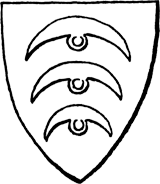
|
Source: Book of Genders of Upper Baden (rough translation from the german original): Berchtold Grüninger, documentary in Haslach 1332. Mister Johans der Grüninger, mayor in Freiburg 1347, dead 1356, had a daughter. Bentz Grüninger, 1367 noble mercenary of the town Freiburg. His seal shows three "Wolfsangeln" (wolf's hooks) on top of each other in the shield: † S. BERTOLDI GRVENGER. Hans Grueninger, also referred to as Hans of Wintzeln and his brother Heinz tythed in 1386 to the cloister Heiligkreuzthal in Warntal. It is remarkable, that as such a connection to the counts of Grueningen-Landau - which always took care about the cloister Heiligkreuztal - might have existed. The counts of Grueningen-Landau and the counts of Wuerttemberg respectively had within their seals as well as in their coats of arms three black deer antler lying upon each other in a golden shield. |
|
Coat of arms of the counts of Grueningen-Landau (Riedlingen) |
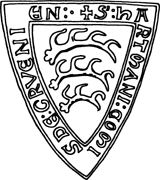 |
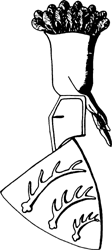 |
|
S. Hartmanni comitis de Grueningen
|
|
|
Source: Nobility and Coat of Arms in Wuerttemberg A brach of the counts of Wuerttemberg-Veringen, the counts of Grueningen-Landau. The marriage of count Hartmann (I.) of Wuerttemberg, did not only yield the remarkable property in upper swabia, but it also brought the veringic family crest into the house of Wuerttemberg. This crest became henceforth the main crest of the house of Wuerttemberg - the three black deer antler lying upon each other in a golden shield. The crest was found the first time as a seal on a document issued in 1228 by count Konrad (III.) of Grueningen, son of count Hartmann (I.) of Wuerttemberg. The gravestone in Markgroeningen of count Hartmann (I.) of Grueningen - son of Konrad (III.) - shows as crest additionally peacock's feathers in a basket. |
|
Family Crest of the minister of Grueningen (Riedlingen), and |
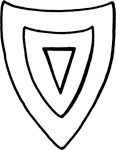
|
A free floating bordure in the shield, and three inwards tapered shields lying upon each other respectively OF GRUENINGEN (Riedlingen): Source: Nobility and Coat of Arms in Wuerttemberg (rough translation from the german/latin original): Village B.-A. Villingen, domicile of an early defunct noble gender. Berchtoldus de Grueningen, after 1109, and Walchon de Grüningen listed between 1111 and 1122 in Rot. Sanpetr. Olim Eberhardus de Grueningen 1138. Unus de Grueningen prope Villingam qui dicebatur ueber homo 1224. Heinricus de Grueningen 1275 canonicus, 1282 cellerarius and Cunradus de Grüningen 1278 canonicus ecclesiae Constant. H. de Gruningen 1287 Z. St. Blasien. Otto de Grueningen, miles, sold 1307 in agreement with his wife Anna and his sons Albertus, Conradus and Otto count of Veringen the fief in Baechingen. H. villicus de Grueningen, civis in Villingen, 1309. Heinrich of Grueningen, R., 1312, 1323, was named on the 18th of October in 1327 along with the cloister Salem, for which he shall serve with his castle in agreement with his sons Albrecht and Otto, his brother Conrad and sons Albrecht and Heinzo. The seals of the knight Heinrich († S'. HEINRICI. MILIT. DE. GRIENIGIN.), his son Albrecht († S'. ALBERTI. DE. GRVNINGEN. IVNIORIS.), who waived in 1323 goods in Ebratsweiler und Herdwangen to the "Johanniterhaus" in Villingen, and the son of his brother Albrecht († S'. ALBERCHTI. D' GRYONINGEN.) had as coat of arms a free floating bordure in the shield, and three inwards taperd shields lying upon each other respectively. Mechtild v. Grueningen 1360, sister in "St. Johann" in Freiburg. Brother Heinrich of Grueningen 1459 Prior, was named in 1451 brother Heinrich Grueninger, Prior, governor and administrator of the "Johanniterhaus" in Villingen. Conrad v. Grueningen named himself probably by the town Grueningen close to Riedlingen in the kingdom Wuerttemberg, who had in 1209 a conflict with the cloister "Zwiefalten", and is supposably the same person as Conrad of Grueningen in 1274, also called of Hornstein. He belonged to the gender of Hornstein. Source: Book of Genders of Upper Baden Conrad of Grueningen named himself presumably by the town Grueningen close to Riedlingen in the kingdom Wuerttemberg, and he was also called "of Hornstein". The barons of Hornstein have been based in Grueningen close to Riedlingen approximately since 750 years ago and were probably the minister of the counts of Grueningen-Landau. |